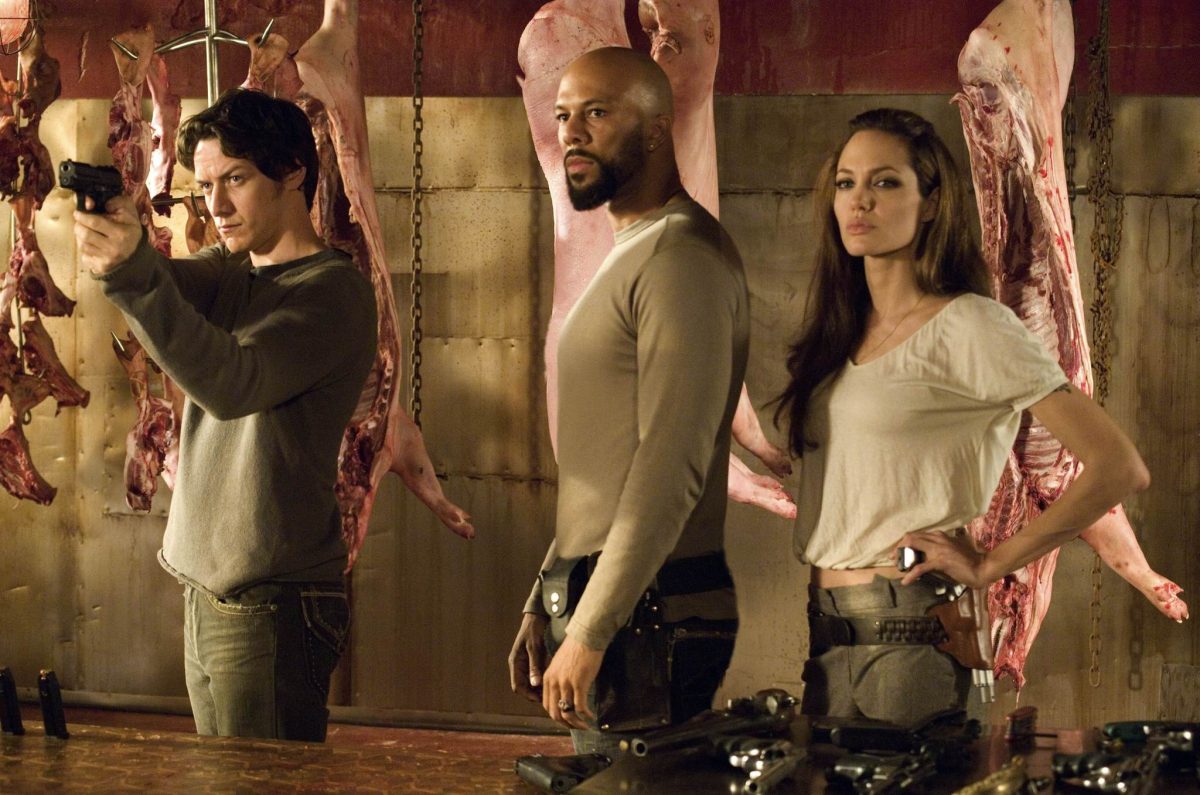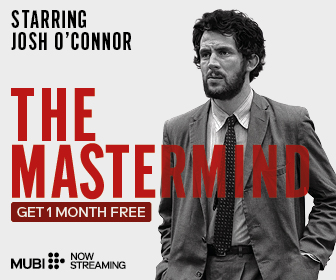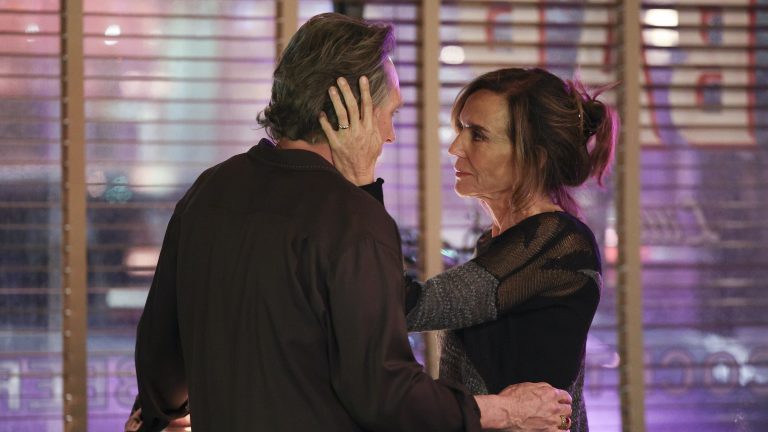In Wanted (2008), the rise and downfall of Sloan, the Fraternity’s calculating leader, fuels the film’s core conflict. Pretending to serve destiny, Sloan twists the Loom’s cryptic code into a convenient excuse for murder — all to feed his own greed and maintain control. When Cross, once their deadliest assassin, learns the truth, he breaks away to shield his son, Wesley, from the same fate. What follows is a brutal odyssey of betrayal, revelation, and vengeance. As Wesley peels back the layers of deception behind the Fraternity’s creed, he turns his guns on the very brotherhood that made him a killer.
Spoilers Ahead
Wanted (2008) Plot Summary & Movie Synopsis:
Why Does Sloan Want to Train Wesley?
Sloan wants to train Wesley because he sees him as a valuable weapon in his vendetta against Cross. Every move Sloan makes, from manipulating Wesley’s grief to forcing him into combat, serves a calculated purpose. Wesley is an ideal target: lonely, disrespected, and unaware of his potential.
He is stuck in a meaningless life with an unfaithful girlfriend and an uninspiring job. Sloan, knowing this emotional void, makes Wesley susceptible to influence. When Wesley learns that his father was a legendary assassin, Sloan uses that revelation to lure him in, offering purpose and power in place of the confusion and pain he has been experiencing.
Sloan presents Wesley’s panic attacks as a gift, not a disorder. This reframing feeds Wesley’s ego and helps break down his hesitation. Sloan doesn’t tell Wesley everything. Instead, he builds a false narrative in which Cross is the villain who killed Wesley’s father. This deception ensures Wesley’s loyalty and emotional investment in the mission to kill Cross.
Although Sloan claims the Fraternity ‘maintains balance,’ his real reason for wanting Cross dead is to cover up his own betrayal. Cross had discovered that Sloan was manipulating the organization’s kill orders for personal gain. Sloan needs Wesley to eliminate Cross before that truth spreads. By training Wesley, Sloan creates a loyal assassin who will do his dirty work under the illusion of justice.
Sloan also uses Wesley’s lineage to his advantage. Since Wesley is the son of one of the most skilled assassins, Sloan assumes he carries the same potential. If Wesley can be shaped into a killer, he becomes both a symbolic and practical solution, honoring his father’s legacy while removing the threat Cross poses to Sloan’s power. Sloan doesn’t train Wesley out of loyalty or duty. He does it to control him, to eliminate Cross, and to protect his position. Every step: manipulation, training, and deception, is part of a larger plan to use Wesley as a weapon without his knowledge.
What Does the Loom Represent?
The Loom of Fate symbolizes control disguised as destiny. It operates as both a literal and metaphorical tool used by the Fraternity to justify their killings. Sloan uses the Loom not only to maintain order but also to manipulate others into serving his personal interests. Sloan introduces the Loom as a sacred instrument that has predicted fates for over a thousand years. It is a divine guide, selecting who must die to preserve balance in the world. For the assassins, it gives their violent actions moral weight. It transforms murder into duty. By relying on the Loom’s messages, the Fraternity members can avoid guilt, believing they are simply instruments of fate.

However, the Loom also represents how easily systems of belief can be exploited. Sloan is the only one who interprets the coded names. This gives him unchecked authority. His power lies not in the Loom itself, but in the perception that it cannot be questioned. When Sloan shows it to Wesley after training, it’s not to inspire clarity but to reinforce control, telling him that Cross must die because the Loom said so.
Wesley, newly confident and trained, accepts the Loom’s authority because it offers structure to his chaotic life. But the Loom, like Sloan’s entire narrative, masks human agendas behind the illusion of fate. It’s less a mystical object and more a symbol of how people are made to surrender free will when told it serves a higher cause.
Why Does Cross Start Killing the Fraternity Members?
Cross, once a loyal assassin, uncovers that Sloan has been manipulating the Loom of Fate. Sloan’s name appeared in the code, which should have marked him for death. Instead of accepting this fate, Sloan fabricates new targets for financial gain, using the Loom as a cover. This betrayal corrupts the Fraternity’s original purpose – killing for balance becomes killing for profit.
Cross sees this as a dangerous misuse of power. The core reason Cross goes rogue is Wesley. He learns that Sloan intends to use Wesley as a pawn. Knowing the truth would make Wesley a threat to Sloan’s empire, Cross understands that the Fraternity will try to recruit and then eliminate him. To protect his son, Cross chooses a violent path. He starts targeting the very organization he once served. Each kill is strategic – meant to thin the ranks and delay their access to Wesley.
Cross never tries to kill Wesley, even when given the chance. Instead, he uses traceable bullets, something he never did before, to lure Wesley toward the truth. His methods are aggressive, but he intends to make Wesley question what he’s being told. He wants his son to break free from Sloan’s manipulation. The fact that Cross saves Wesley during the train fight, even while being hunted by him, proves his motivations are rooted in love, not revenge.
Despite his efforts, Cross fails to reveal the truth before Wesley kills him. Only after Cross dies does Wesley learn that the man he believed to be his enemy was his real father. It’s a tragic irony: Cross dies trying to save Wesley from a lie that Sloan engineered. Ultimately, Cross kills the Fraternity members not to destroy the order, but to preserve its original purpose, and more importantly, to save his son from being used and discarded.
Wanted (2008) Movie Ending Explained:
What Happens to Sloan?
Sloan’s downfall is a result of his own deception, ambition, and underestimation of those he manipulates. Though he tries to maintain control until the end, his betrayal ultimately leads to his death at the hands of the man he tried to use. Wesley storms the Fraternity’s base with explosive rats and eliminates the remaining assassins.
In Sloan’s office, he confronts the man who orchestrated the lies. Wesley reveals that Sloan forged kill orders and twisted the Loom’s messages for personal gain. Sloan does not deny it. Instead, he claims his name appeared in the Loom alongside everyone else’s and insists he acted to protect them. He offers the remaining assassins a choice: follow the code and die, or abandon it and help him shape the world.
Sloan bets on their loyalty and fear. But his miscalculation lies in overlooking Fox’s belief in the Fraternity’s original principles. When she realizes she has been living a lie, she aims a bullet to kill everyone in the room, including herself. It is a moment of silent defiance – honoring the code over loyalty to Sloan. In the chaos, Sloan escapes, using the moment to disappear once again. Sloan believes he still has control. He finds Wesley, seemingly broken and back at his old desk job. But this is a setup.
The man in the chair is a decoy. Sloan is caught off guard. From a distant vantage point – his father Cross’ apartment – Wesley shoots him with a sniper rifle. The kill is precise and symbolic. Sloan dies not just by Wesley’s hand, but through the skills passed down from the man he tried to destroy. Sloan’s end is both physical and ideological. He spends years twisting fate to suit his ambition. In the end, fate turns against him. His empire collapses, his lies are exposed, and the son of the man he betrayed brings him to justice.





![The African Desperate [2022] Review: A mostly funny satire that delivers occasionally but ultimately fails to leave a mark](https://79468c92.delivery.rocketcdn.me/wp-content/uploads/2022/10/The-African-Desperate-2022-Movie-Review-768x432.jpg)

